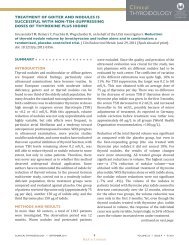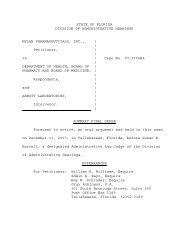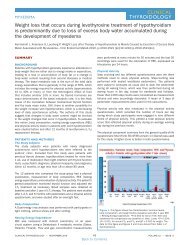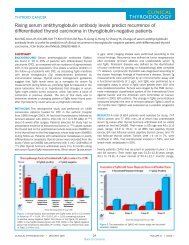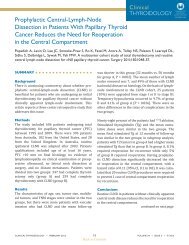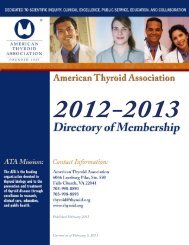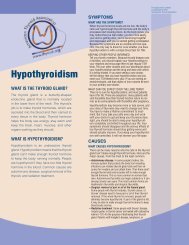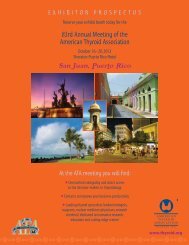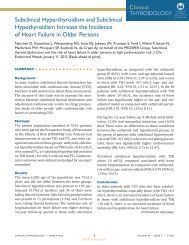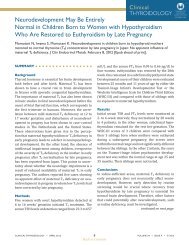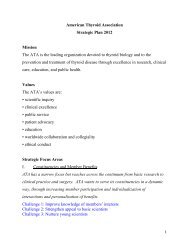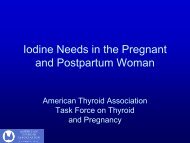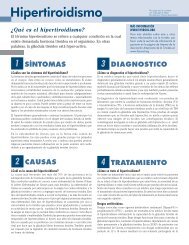Clinical Thyroidology February 2013 Entire Issue - American Thyroid ...
Clinical Thyroidology February 2013 Entire Issue - American Thyroid ...
Clinical Thyroidology February 2013 Entire Issue - American Thyroid ...
Create successful ePaper yourself
Turn your PDF publications into a flip-book with our unique Google optimized e-Paper software.
How Important Are Preexisting Comorbiditiesand Genetic Proclivities in Explaining the IncreasedRisk of Mortality in Hyperthyroidism?Brandt F, et al.as compared with the euthyroid sibling, over a meanfollow-up period of 10.5 years. A similar increasewas found when the twin with hyperthyroidism wascompared with its four control twins. In the 418same-sex dizygous twin pairs, the HR was 1.80 (95%CI, 1.27 to 2.55), as compared with the euthyroidsibling. In marked contrast, when the 201 monozygoustwin pairs were compared, the mortality in thesibling with hyperthyroidism was not significantlydifferent from that of the unaffected sibling. Whenthe 413 twins who had had no comorbidity prior tothe diagnosis of hyperthyroidism were studied, againthe dizygous twins with hyperthyroidism still hadincreased mortality, yet the monozygous twins withhyperthyroidism did not.ConclusionsIn singletons with hyperthyroidism as well as insame-sex dizygous twin pairs discordant for hyperthyroidism,the risk of mortality is increased, independentof any medical conditions documentedbefore the diagnosis of hyperthyroidism was made.In contrast, mortality in same-sex monozygous twinsdiscordant for hyperthyroidism may be more influencedby genetic factors.ANALYSIS AND COMMENTARYOne might question the validity of lumping twinswith Graves’ disease together with twins with toxicnodular goiter, because of the well-recognizedgenetic component of Graves’ disease. It therefore isworth noting that Swedish patients hospitalized withtoxic nodular goiter were found to have twice the riskof having a sibling who also had toxic nodular goiter,versus the risk of patients hospitalized with Graves’having a sibling with Graves’ disease, although thenumber with toxic nodular goiter was much smallerthan the number with Graves’ disease (1). Over the31 years that the Danish data were being recorded,methods of testing, diagnostic criteria, and therapiesfor many diseases improved, and some of the deathcodes used and the individuals who performed thecoding underwent changes. Furthermore, the relativefrequency of different causes of hyperthyroidism inDenmark also changed, since dietary iodine levelsand the relative incidence of Graves’ disease versustoxic nodules underwent major shifts during theperiod of the study. In addition, subacute hyperthyroidismand transient hyperthyroidism due to thyroiditisbecame better recognized. Another issue isthe possibility that hyperthyroidism was induced inpatients with preexisting cardiovascular conditionswhen iodine-containing drugs or contrast agentswere administered. The assessment of comorbiditiesmay also be incomplete, since some diseasesknown to be associated with hyperthyroidism, aswell as some complications known to be producedby therapies for hyperthyroidism, might not havebeen noted in the Charlson score, as it is based ononly 19 common diseases.Information concerning thyroid-function tests,therapies used, the period between diagnosis andrestoration of euthyroidism, recurrences, and soforth was not available. It might have been instructiveto show the survival curves after hyperthyroidismwas diagnosed, in view of earlier studiesshowing that the excess mortality after treatmentwith radioiodine occurred mostly in the first year(2), and also to look for possible time trends in thecauses of mortality.Notwithstanding these caveats, such studies are verydifficult to do, and are important if we are to eventuallyunderstand why (and when) patients with hyperthyroidismare at increased risk of mortality.continued on next pageCLINICAL THYROIDOLOGY • FEBRUARY <strong>2013</strong> 38 VOLUME 25 • ISSUE 2 • © <strong>2013</strong>Back to Contents



